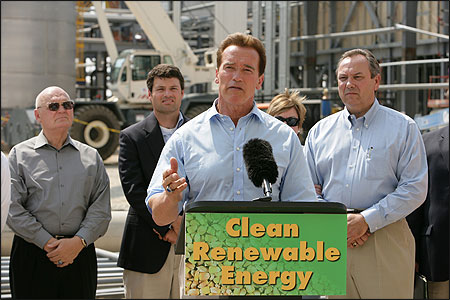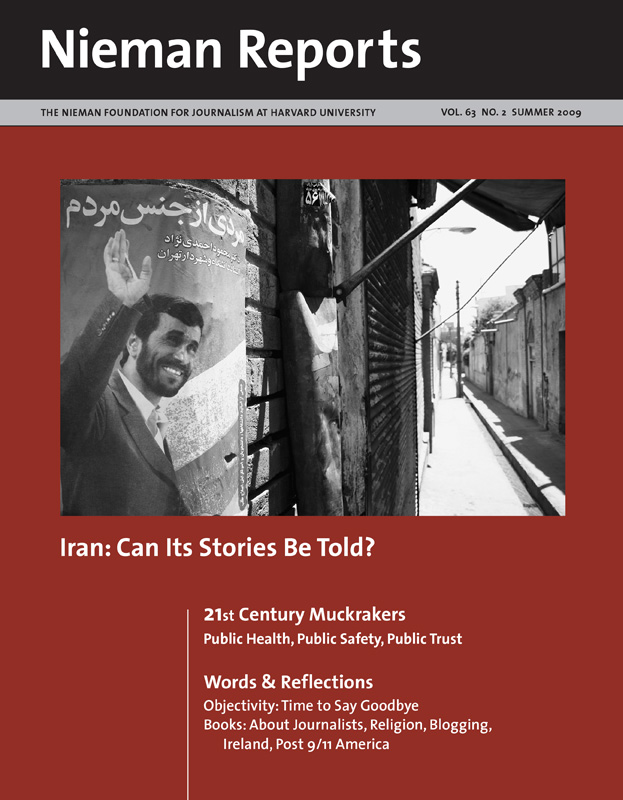
Governor Arnold Schwarzenegger and, on the right, Bill Jones, a cofounder of Pacific Ethanol, at the July 2006 announcement of the governor’s bioenergy action plan.
In his 2007 State of the State speech, Governor Arnold Schwarzenegger launched the world’s first low carbon transportation fuels standard for California. He touted the benefit of using biofuels, derived from crops such as corn-based ethanol and other plant-based feedstocks, to power cars as a way to produce fewer greenhouse gas emissions than gasoline. Carbon-light alternative fuels, he proclaimed, would strengthen the state’s economy and security and improve its environment.
Moving these less polluting biofuels from the farm to the highway would take far more than regulations, he said. Instead, the marketplace would power this change, with standards paving the way. In early 2007, Schwarzenegger appeared confident that the free hand of the market would produce the necessary amount of less polluting plant-based fuels. At the same time, however, the governor, who portrays himself as a gung ho environmentalist, saw no need to give up his gas-guzzling Hummer. Rather, he’d power it with an alternative biofuel.
From the start of this initiative, it was clear how critical it would be to have a watchdog press keeping track of this unfolding effort. Given that much of this groundbreaking effort would circumvent traditional channels of the legislative process, there would be even less of a chance for opposing views to be publicly aired and covered by the news media. Yet it seemed vital that consumers understood what was about to happen.
Given my years of energy reporting in California, I could spot several warning signs early on; others took additional reporting to uncover. The first red flag was visible right away. Positing this biofuels policy as a technical solution to a multilayered and complex set of energy and environmental problems was too good to be true. Soon, the second red flag emerged when, a few days after his announcement, the governor issued an executive order—effective immediately—mandating that California regulators create the low carbon liquid fuel standard blueprint.
An executive order isn’t vetted as an actual bill would be over a course of weeks and months. While the legislative process is slower and more challenging, it is also more open—for taxpayers and the press. I’ve watched numerous bills get tangled in tit-for-tat legislative politics and, in the end, be tabled. But the deliberative process allows for a public airing and debate about proposed statutory provisions. Furthermore, interactions among stakeholders during hearings provide clues into what is going on behind the scenes from highlighting what really is at stake to showcasing the inevitable jockeying for power.
The importance of such open and public decision-making hit home for me well before the biofuels beat grew in importance and complexity. When I covered California’s 2000-01 energy crisis—a time when information blackouts were far more prevalent than power outages—then Governor Gray Davis and his top staff secretly negotiated at breakneck speed $42 billion worth of energy contracts. Many of these deals were overpriced and mismatched to the state’s energy demand, and they significantly altered the energy landscape. It took utility customers years to pay off the tab (and cost Davis his job). This debacle highlighted the critical role the press has to play in monitoring this kind of close-to-the-vest dealmaking and the absolute necessity of public access to such information.
Fast-forward to 2007, when this governor pledged that rules would be developed to ensure carbon-light biofuels would slash 13 million metric tons of carbon emissions in 13 years. By using crops and other plants to fuel transportation, Schwarzenegger intimated that Californians would not need to alter their energy-consumptive lifestyles.
Red flag number three then surfaced. Although oft repeated, the devil is in the details, yet few specifics about how any of this would work emerged at or after the governor’s announcement. Given the complexity and high stakes of this proposed development of a statewide alternative fuels policy, there was sure to be a lot of power brokering going on behind the scenes. To keep an eye on all of this, the press watchdog was needed.

A woman in Indonesia harvests palm to be used as a biofuel. Photo by Tom Picken/Friends of the Earth.
Questions to Be Asked
As our staff reported this story for California Energy Circuit, a subscription-based and ad-free independent journal read by those with a stake in energy issues in the West, we sat in on obscure meetings. We read dense reports. We asked questions—lots of them—of scientists and other energy experts. We also spent time figuring out how the terms of the debate were being defined—and by whom. We did this because defining terms matters a lot in this new energy arena. How a particular word is defined and used affects decision-making and its implementation.
As development of regulations began, a lot of assumptions were on the table. Primary among them was that fuels made from corn, sugar cane, soybeans and other plants would help to slow climate change. Initial tests showed that corn-based ethanol fuel produces fewer carbon emissions than gasoline. However, the formula failed to take into account what happens when fields to grow corn expand into rainforests, wetlands and other sensitive lands. Add in those factors, and overall carbon emissions are higher.
On the global front, the expansion of crops to create biofuels to feed cars instead of people—supported by the European Union and the Bush administration—already had caused prices of essential staples to soar. People in struggling nations rioted in protest as the price of essential food stocks rose. That situation also had served to shift the focus of policymakers and regulators from crop-based biofuels to waste feedstocks, such as biomass.
Following the Money
Market forces also need to be brought into reporting about biofuels. For us, this meant keeping a watchful eye on those in California seeking a piece of the multibillion-dollar alternative fuels market. By what means were individuals and companies gaining a foothold? Were backroom deals part of the equation? The governor professed neutrality about which potential biofuels would likely qualify under the low carbon fuels standard in California, while ethanol blends were ranked first and second on a list of top 10. And standing on stage when the governor made his low carbon fuels standard announcement in January 2007 was Bill Jones, a former secretary of state and Republican lawmaker who had launched an ethanol production company in California called Pacific Ethanol. Jones had also been at the governor’s side for his 2006 announcement of the Bioenergy Action Plan.
Certainly, the press handling this story in California has had an important investigative role to play in finding out to what degree taxpayers get stuck with any of the tab for private sector investments. No doubt this situation will confront journalists in other states as similar measures emerge.
Digging into the financial interests of the entity or person promoting an existing or emerging energy source is essential. As things turn out, discovering the details of such transactions can be hard. But sticking with the hunt is part of the fun. A few months after the governor’s biofuels’ announcement, British Petroleum (BP) announced a $500 million deal with University of California, Berkeley and two other partners to create a bioenergy laboratory. BP’s proposal to own a part of a public university, as well as the large size of the agreement and its hidden terms, generated significant public controversy.
I devoted weeks of reporting in trying to get hold of the agreement. I didn’t succeed and only could read the terms of the deal once they were released and after the contract was a done deal. When I finally read the agreement, it revealed that BP would be permitted access to the work of the university researchers. However, access to the oil company’s work would be restricted.
I’ve covered the energy beat for nearly two decades and rarely have I seen this kind of skewed arrangement between public and private entities. Certainly, the practice of suppressing technology or scientific information is not without precedent. Think “Who Killed the Electric Car?.” What was worrisome and different, in this case, was not having the opportunity for prior oversight by legislators—or journalists—of such a major agreement, given its enormous implications for future energy policy.
Navigating through this emerging biofuels debate is challenging and EDITOR'S NOTE:
The board’s regulation requires providers, refiners, importers and blenders to ensure that the fuels for the California market meet an average declining standard of “carbon intensity.” This is established by determining the sum of greenhouse gas emissions associated with the production, transportation and consumption of a fuel, also referred to as the fuel pathway. Economic mechanisms will allow the market to choose the most cost-effective clean fuels, meaning those with the lowest carbon intensity.fascinating. Trying to untangle its intersecting issues reveals the many complicated interconnections between them and the global forces involved. As Franklin D. Roosevelt once observed, “The throwing out of balance of the resources of nature throws out of balance the lives of men.”
It’s now more than two years later, and the biofuels revolution that Governor Schwarzenegger unleashed in California is still underway. In working to create a low carbon transportation fuels standard, the California Air Resources Board encountered a morass of unintended and overlooked consequences highlighted by a flood of studies and reports warning of biofuels’ environmental downsides. Yet in April 2009 the board adopted a standard. Mary Nichols, the board’s chairperson, observed that, “We are attempting to set in motion something that will take several years to implement.”
However, the answer to the key question of which plant-based fuels have lighter carbon footprints than gasoline remains unclear. At the same time, the urgency of calls for curbing global warming are escalating worldwide and the energy market—especially investments in alternative energy sources (biofuels, wind, solar)—has tumbled like the rest of the economy.
What this episode from the frontlines in the energy wars teaches us is why reporters need to understand the complexity of these issues and be willing to ask tough questions until answers are given. And it means monitoring those who are gaining power and poised to profit in the transition to new sources of energy.
Elizabeth McCarthy is the coeditor and co-publisher of California Energy Circuit, an independent publication that reports on government policy and energy and climate change issues.
